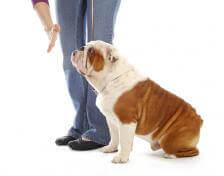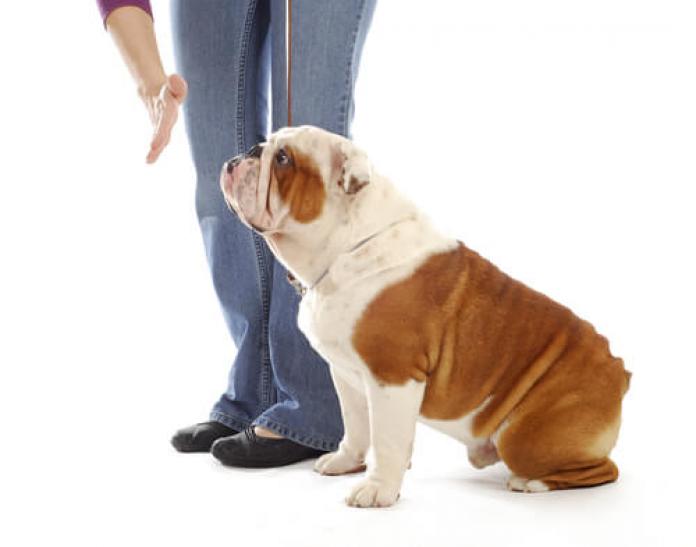How to Train Your Dog Better
Think about training the right way – you’ll be more effective (and it’s more fun, too).

Now, this is fine–training does involve teaching dogs specific behaviors with a step-by-step approach. This week, though, I’m going to discuss three mental habits that will not only enable you train more effectively but also make life pleasant for both you and your dog. All this, without magic, mojo, or one single drop of noni juice.
How to Train Your Dog Better
In any given situation, focus on what you do want your dog to do instead of on whatever he’s doing wrong. For example, suppose that on many evenings, your young dog gets busy looking for trouble just as you’re digesting your dinner.
He grabs a boot from the mat by the front door and gallops through the house with it. You yell at him and take it away. He grabs its mate. You yell and take it away. He heads for the kitchen and starts checking out the counters in case something tasty’s been left behind. You chase him away. And on and on, until you’ve lost your temper and torn out clumps of hair you can ill afford to lose.
You want Zippy not to steal your shoes and not to countersurf. You punish the heck out of him for these activities, never mind how, and sure enough you get him to quit. But the next night, you find that he has quietly chewed through two table legs while you obsessed over the final episode of Lost. Now you can punish him for that, and, assuming you’re successful, for the next activity he comes up with, and the one after that, and the one after that.
Train Your Dog Better By Focusing on Good Behavior
Okay, I’m exaggerating for effect. But notice how many things Zippy can do wrong over the course of an evening.
In contrast, how many things are there that he can do right? It’s a safe bet there are only one or two, and they involve lounging around quietly. You can spend a lot of time punishing Zippy for all the things he does wrong, or you can spend a little time setting him up to do something right. So there’s your task–figure out how to get Zip to act all loungy-like.
Let’s say Zippy’s a year old and most days he gets 20 minutes of morning fetch. He spends the day by himself, except for a short visit from the dog walker, while you and your wife are at work. Then, in the evening, what do the humans do? They hit the couch. Young dog, antsy, nothing going on: he’s climbing out of his skin with pent-up energy and he is bored.
So you gird your loins and add an early-evening fetch session to Zippy’s day. You also deliver dinner in a food-dispensing toy. While you’re at it, for a bit of insurance you gate the kitchen and hide the shoes as well. Zippy’s pleasantly tired from his game of fetch and has a project to occupy his mind. When he’s done extracting dinner from his toy, he curls up on the couch next to you and goes to sleep.
Figuring out what you do want from your dog in a given situation is almost always quicker and easier than killing off the 437 behaviors you don’t want. It’s a lot easier on your relationship with your dog, as well. Teach the desirable behavior, or put your dog in a position to do it spontaneously, then kick back, relax, and enjoy the show.
Train Yourself to Notice Good Dog Behavior
Here’s a common sight. A person is walking with her new puppy, who’s trotting along next to her, giving her that “Hey! I’m walking with my person!” look. The person, however, isn’t looking at Pupaloo. She’s just walking along. There may be an iPod or cellphone involved.
Suddenly, Pupaloo stops dead. He’s fascinated by the dirt in a crack in the pavement, or he’s pumping his nose full of McDonald’s aroma thanks to the jerk who dumped that greasy wrapper next to the curb. Or a friendly passerby wiggled his fingers and smiled at Pupaloo. Whatever it is, it trumps the puppy-ignoring person at the end of the leash.
Now, when the pup stops dead, what does the person do? She turns to the puppy. She says, “Hey!” and “What’s up, Pupaloo?” and “Come on, let’s go!” She wiggles her fingers at the puppy just like that enticing passerby did. Maybe she digs out a treat and puts it a few inches in front of the puppy’s nose to get him moving.
How Puppies and Dogs Learn
So what has the puppy just learned? “Oh hai! Walking next to my human and paying attention to her is boring and pointless. However, stopping dead in my tracks gets attention, and finger wiggles, and possibly a treat.” If Pupaloo is a slow learner, he may need three or four repetitions of this scenario before he’s really got the knack, but sooner or later this puppy’s person will be telling friends and trainers that he constantly stops dead on walks. He’ll move if you show him a treat, but five steps later he just stops again. It’s so weird!
The trap this puppy’s person fell into, of course, is that she completely and utterly failed to notice her puppy’s quiet, unobtrusive, not-much-happening-here, highly desirable behavior of walking attentively next to her. Because she didn’t notice it, she didn’t reward it. Behaviors that don’t net a dog appealing results wither and die. Behaviors that get attention and treats thrive and grow.
Are You Missing Your Dog’s Good Behavior?
In any given situation, focus on what you do want your dog to do instead of on whatever he’s doing wrong.
A lot of the behavior we like from dogs is unobtrusive and easy to miss. The doorbell rings and your puppy remains quiet. You’re cooking dinner and your dog lies down without being underfoot. You’re at the vet’s and your dog calmly accepts having his temperature taken.
In each of these cases, the dog could have done something else–he could have barked at the doorbell, or jumped up toward the cooking pot, or snarled at the vet tech. But we tend to take low-key, desirable behaviors for granted. We often ignore them, when the wiser course is to reward the heck out of them and make sure to keep them strong. Teach yourself to notice those moments when your dog doesn’t bark, when he doesn’t jump up in your face, when he puts up with exam procedures that many dogs resist.
As for the woman walking her puppy, the solution to her new problem is usually to turn the scenario inside out. When the puppy stops dead, the person should be quiet and pay him no mind. As soon as he’s walking along nicely again, she should offer plenty of attention and treats.
Be Prepared When Training Your Dog
Many people fall into the trap of reacting to what their dog does. They open the front door and the dog runs out–oops, now they’ve got an emergency. They let their four-month-old puppy out of his crate in the morning and then, when the puppy toddles off to the far corner of the living room and pees on the rug, they shout at him and hit the yellow pages looking for rug cleaners.
Preparation feels like more work, because you have to drag yourself out of your own inertia. Believe me, I’ve been there. But if you consider the longer term, preparation almost always saves you time and energy. Taking your pup out to her pee spot right away, even if you just realized you’re desperate for your coffee, winds up being less trouble than cleaning the rug. In some cases, like that of the dog bolting out the door, a little preparation in the form of a leash can save vet bills and heartbreak as well. (And, of course, you can teach your dog to wait for permission before going out an open door.)
The puppy who rushed out of her crate and peed on the rug has just practiced, you guessed it, peeing on the rug. The more practice she gets in peeing on the rug, the longer housetraining will take, and the higher the odds that it’ll never completely succeed. The dog whose guardian has always prevented him from dashing out the door will have an easier time learning to wait for permission to exit than the dog who’s had plenty of practice running out. Preparation prevents mistakes. The fewer the mistakes, the faster the training.
You ever notice all those Internet ads offering to sell you the mysterious secrets of dog training? Here they are: Focus on what you want from your dog, and teach her that. Teach yourself to notice and reward good behavior. Be prepared, so you can set your dog up to make the right choices. Love your dog. Have a good time.
I welcome your comments and questions – email dogtrainer@quickanddirtytips.com. And you can talk to me on Facebook, where, amazingly enough, I’m The Dog Trainer. Dogalini is me on Twitter. That’s it for this week – thanks for reading.
Image courtesy of Shutterstock


